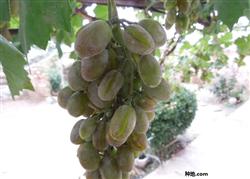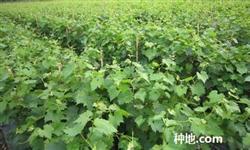How to grow American black grapes?

How to grow American black grapes? To find a way to grow American black grape, you can refer to the following methods: core hint: it is better to set up a garden on a leeward and sunny slope, and the soil quality requires sandy soil or loam with strong fertilizer and water conservation. Before planting, dig a planting ditch that is 100 cm deep and 80 cm wide. The bottom of the ditch is 667 m 2 and the soil and miscellaneous fertilizer is 4000ml 5000 kg. Seedlings choose last year's striped seedlings or cuttings, requiring more fibrous roots, strong branches and full buds. Before planting, soak the seedlings in clean water for 2 days to let the seedlings absorb enough water. Then the root garden should be planted on the leeward sunny slope, and the soil quality requires sandy soil or loam with strong fertilizer and water conservation. Before planting, dig a planting ditch that is 100 cm deep and 80 cm wide. The bottom of the ditch is 667 m 2 and the soil and miscellaneous fertilizer is 4000ml 5000 kg. Seedlings choose last year's striped seedlings or cuttings, requiring more fibrous roots, strong branches and full buds. Before planting, soak the seedlings in clean water for 2 days to let the seedlings absorb enough water. Then dig holes and plant according to the size of the seedlings. It is better to plant 333 plants with row spacing of 1 m × 2 m and 2 plants of 667 m, and pour water after planting to make the seedlings sink. The grape under fertilizer and water management can be fertilized three times in the same year to promote the healthy growth of seedlings. (1) in early June, the plant was given 50 grams of diammonium phosphate and 50 grams of urea. (2) 150 grams of compound fertilizer can be applied in the first ten days of August. (3) completed in early October, 100 grams of diammonium phosphate or 150 grams of compound fertilizer can be applied. After winter shearing in the first year, 667m 2 applied 3000 kg organic fertilizer and 100kg compound fertilizer. In the future, according to the growth characteristics, 0.3% potassium dihydrogen phosphate and 0.3% 0.5% urea solution can be sprayed on the leaves in the period when more fertilizer is needed, such as shoot growth and berry expansion. Black grape needs a lot of water for its growth. Besides watering enough water at the same time, it can also water enough before sprouting, inflorescence appearance and flowering, after flowering, before berry coloring and soil freezing, according to soil moisture and rainfall. Shaping and pruning should adopt single-stem and double-arm hedge wall shape, that is, after the seedlings sprout, take off the core and set the stem at the place of 60cm in the main vine; after the trunk is coring, leave the two lateral buds above to form a secondary shoot, and when the auxiliary tip is about 60cm long, leave 50cm coring and tie it to the first layer of wire to form double arms; the first layer of wire is about 60cm from the ground. The accessory shoots on the arms can leave 5 murine 7 leaves to pick the heart, and then grow 1 Mel 2 leaves to pick the heart. From now on, when you cut every winter, you only need to cut the fruiting mother branches on your arms. Generally, there are 6 fruiting mother branches in each arm. The fruiting mother branches are trimmed with short shoots every year, and the rest of the secondary shoots droop naturally. Flower and fruit management Heti grape has large ears and close fruit, so thinning flowers and fruits should be carried out as soon as possible. The extra large spike, abnormal spike and extra spikelet can be removed at inflorescence or post-anthesis grain formation stage, and the spike tip should be removed if the weight per spike is not more than 1000 grams. At the same time of removing tendrils, wiping buds and thinning branches in summer, the secondary inflorescence was removed, and the small and abnormal grains in the ear were removed, and the tight ear could remove part of the grain. Click to see more grape planting techniques click to see more fruit planting techniques
- Prev

Why do grapes split? How to prevent and cure
Why do grapes split? How to control table grape is an important tree species in fruit cultivation in China at present, but fruit cracking often occurs before grape harvest, especially in rainy years in the later stage of fruit ripening. Fruit cracking not only affects the appearance of the fruit, but also leads to the infection of exogenous microorganisms.
- Next

How to improve the fruit setting rate of Jufeng grape?
How to improve the fruit setting rate of Jufeng grape? Is there any way? Jufeng grape has serious flower failure, low fruit setting rate and loose ear. Re-picking can increase the fruit setting rate, increase the yield and improve the quality of Jufeng grape. 7-10 days before flowering, the fruiting branches retain 2-3 leaves and 5-6 vegetative branches above the flower spike.
Related
- Moge, come on! The staff of the peasant association in the producing area of cantaloupe were frightened when the crowd gathered.
- Causes and Solutions of low Fruit setting rate of Apple
- Symptoms and control measures of passion fruit virus disease
- Fruit growing lesson: how do apple orchards keep high yields?
- Can you build orchards in the mountains? What are the pros and cons?
- How to manage the coloring period of Crisson grape?
- This paper introduces the processing technology of two kinds of fig products.
- How much is a month for retired teachers in rural areas by 2020?
- How can strawberry planting increase sugar content? We should pay attention to management in many aspects.
- What are the cultivation techniques on how to improve the yield of golden fruit?

